Your Free Copy, Return to AdventurePrepared by Harold Stephens
Travel Correspondent for Thai Airways International
In an attempt to tell people that Southeast Asia is more than temples and good shopping, that Southeast Asia is really a land of adventure, I wrote a book titled Return to Adventure. Thai Airways International sponsored the book and thousands of copies were distributed to Royal Orchid Holidays offices at THAI destinations around the world. The book was very well received.
For those who are interested in adventure in Southeast Asia, the book is still available, and we are offering copies free to anyone who wants one. All that is needed is to pay the handling and shipping charges. The process is simple: just e-mail the publisher, www.wolfendenpublishing.com for information on how to get your free copy.
To tell readers more about Return to Adventure, I would like to quote in part from the Introduction:
Return to Adventure is not a guidebook, nor is it intended to serve as such. Rather, it has been written to introduce readers to a side of Southeast Asia that has long been ignored—Southeast Asia's world of adventure.
That Southeast Asia has an intriguing and alluring outdoors may come as a surprise to many. We have fixed images of Asia that are hard to overcome. The very mention of Asia and our minds conjure up all kinds of preconceived ideas. Take Thailand. Thailand presents an image of enchantment that's hard to dispute. It's a land of golden temples with tiny bells that tinkle in the breeze; a country with green mountains, tropical forests and endless offshore islands; a nation of smiling people and happy children, and monks in saffron robes moving in silent animation; a country interlaced with rivers and canals, with rice barges, teak logs floating down rivers, ferryboats and river buses all gliding along in a kaleidoscope of changing colors.
This image of Thailand is real enough, but it's not the complete picture. Thailand is more than golden temples and smiling faces. Thailand has adventure lurking in its midst, at every turn. Its mountains are a challenge for both rock climbers and mountaineers; its wild rivers churn with white water for daring rafting and kayaking; it has trails to hike or cycle through majestic hill tribe villages and lovely tropical forests; it has ocean floors littered with wrecks to investigate; it has ancient ruins and archaeological sites still to be uncovered; and for the spelunker, amateur or professional, it has caves to explore. The fact that Thailand has unexplored caves is news to some, but even more astounding is that these underground caverns number in the tens of thousands. The caves of Thailand are only one of the country's greatest mysteries.
Consider other countries of Southeast Asia—Malaysia, Singapore, Indonesia, Myanmar, Laos, Cambodia and Vietnam. Nor can we forget the Philippines, and all of East Malaysia that is Sabah and Sarawak on the island of Borneo. They all, even tiny Singapore, have their images, beneath which lie the hidden world of adventure.
Travelers were once contented to sit in Raffles Hotel in Singapore and listen to the bartender at the Long Bar tell them about the tiger that was shot under the billiard table back in the 1920s. It didn't matter the tiger had escaped from the zoo. And tourists felt comfortable just to sit in a Tudor-style lodge in the Cameron Highlands in Malaysia knowing that outside their very door was a forest where elephants and tigers roamed.
Tastes in travel do change. Travelers want something different—adventure. For years even the spirit of adventure was dead. It wasn't so long ago that whenever I talked about going off to explore the jungles of Borneo or about sailing aboard a trading schooner in the Pacific, people would scoff. "You can't do that anymore," they said. "Those days are gone."
Today it's quite different. People are interested in adventure. The reawakening of adventure is very encouraging. We all share this earth together, and it can be a very exciting place if we let it be. Adventure, or call it discovery if you wish, adds a new dimension to our lives. It gives us purpose.
We often confuse this "reawakening" of adventure with nostalgia, that is, dreaming of a return to the "good old days." Movie films and TV drama depict the past, and we become lost in reverie. And certainly when we read the pages of Somerset Maugham and Joseph Conrad, and the book on our lap falls shut, our imagination runs back through time. "Those were the days," we sigh. "To have lived a hundred years ago!"
Granted, a hundred years ago, or even thirty or forty years ago, the world was very different, but how few of us ever stop to realize that adventure is not something in the past. It's now. It's happening all around us, all the time. The problem is knowing where to look. We turn to new horizons.
Southeast Asia is a new horizon, a vast unknown land. People look askance when I mention this. Despite the fact that the bulk of the world's population lives in this region, there are still areas, mainly the jungles and mountain plateaus, that remain unexplored. Stone Age people continue to be discovered in the Philippines, and there are tribes of Punans in Borneo who have never seen an outsider.
We have hardly begun to scratch the surface of Southeast Asia's past. Written history began when the first Europeans arrived. But the Chinese and Indians had been trading by land and by sea for as many as 5,000 years. They had well established trade routes, trading posts and even cities, centuries old and long forgotten by the time the Portuguese arrived. Early Chinese chronicles from the Seventh Century AD make mention of such cities, or trading posts, located up the dark rivers of the Malay Peninsula. Yet no one has uncovered these sites. It seems that modern man is more interested in finding oil than in discovering another Angkor Wat.
Thai fishermen sparked off the spirit of adventure a few years ago when they located a wrecked Chinese junk in Sattahip Bay in Thailand. It was a sensational discovery. Its cargo contained priceless Sawankaloke pottery. How many hundreds—perhaps thousands—of other such vessels were lost through thousands of years of trade? In the relatively short span of 500 years, England claims to have had 220,000 wrecks along her shores. Think of Asia, where few divers have ever ventured.
An incident that has always fascinated me was the sacking of Malacca by the Portuguese in 1511. Malacca was an incredible port, even larger than Genoa and Venice at the height of their glory. The Portuguese commander, d'Albuquerque, spent some nine months loading his ship with the spoils and riches of Asia. Three days out of Malacca bound for Europe, the ship was lost in a squall off the coast of Sumatra. The wreck has never been found, nor, to my knowledge, has anyone ever looked for it.
I mentioned the jungles but what about the islands. To explore the islands and rivers of Southeast Asia, I built and outfitted my own schooner Third Sea, and found that the world Joseph Conrad had described in his novel, Lord Jim, was not dead. Imagine sailing into a port in Java, where Macassar trading schooners tie up to the quay, side by side, forming a line a mile long. These schooners, with jutting bowsprits and ratlines running up the rigging, measure a hundred feet long. They have no engines; they enter port by kedging, just like the square riggers of old did. For the daring adventurer, it's possible to find a berth aboard one of these schooners and sail with them to any one of the thousands of islands that make up the Indonesian Archipelago.
Or imagine sailing in the shadowed sides of islands where smoking volcanoes rise up from the blue sea, or stepping ashore on beaches where the descendants of dragons ten feet (6.3m) long still survive. And maybe somewhere in that Indonesian chain of 13,000 islands there is another Bali where no tourist has ever intruded. It is possible.
When you knock around Southeast Asia long enough, you become fascinated by the mountains, and there are some great challenging peaks, all the way from Japan down the Malay Peninsula to Borneo. To reach the summit of the highest peak in central Malaysia you must first chop through primary jungle. It takes a couple of days just to reach the base of the mountain. To reach the summit of the highest peak in Southeast Asia, Mount Kinabalu, you must climb to 13,450 feet (4100m). By Himalayan standards it's not terribly high, but when you begin at sea level, it's quite another thing.
The orang aslil, along with the hill tribes of Bangladesh, Burma, Thailand, Laos and Vietnam, are fascinating to anyone interested in anthropology. The Negritos of the Malay Peninsula and the Punans of Borneo still live in the Stone Age. I have lived for a short time with both, but to research their way of life would take a lifetime.
In the days when Somerset Maugham traveled in Southeast Asia and wrote about the things he saw and the people he met, the sport was big game hunting. Hunters thrilled in having their photographs taken with a booted foot propped up on the carcass of an elephant. We can be thankful times have changed. The fun today is to chase wild animals, especially dangerous ones, with a camera. There might be more excitement there than one bargains for. On an assignment in Assam at the Kazaranga Game Reserve, I rode with rangers on elephant-back while they checked the wild elephant herds coming down from Tibet. I felt perfectly safe until a rogue elephant in heat broke through-the thicket. The elephants we rode were females! I was too preoccupied with my own safety to think about getting pictures.
When you are at a jungle camp, orang asli sit around the campfire at night and tell tales about man-eating tigers that have carried away members of their tribe. It can send a chill right through you when in the black of night you hear a tiger roar. One's immediate reaction is to stoke the campfire, until you remembered that roaring campfires attract elephants. A tough decision to make.
For the spelunker, or cave explorer, Southeast Asia is prime territory. Geologists tell us that Asia was once connected to Australia by a land bridge. For millennia the land has been eroding, leaving many limestone outcroppings that appear like city skyscrapers. Most are hollowed out and deeply caverned, and it was here that early man found shelter. Niah Caves are the best known. Java Man occupied these caves 35,000 years ago. Also well known are the Batu Caves a few miles north of Kuala Lumpur. Thousands of tourists visit the main cave every year, but few ever venture into any of the other caves that extend deep into the mountain.
Return to Adventure is only an introduction to Southeast Asia's great outdoors. The material presented in the book is based on my own personal experiences, with the hope that it will encourage others to enjoy Southeast Asia's outdoors as I have. Adventure doesn't necessarily have to be hard-core, fighting rapids or climbing mountains. It can be as simple as taking a train trip, getting behind the steering wheel of a car or Jeep and motoring, or joining a bird-watching group.
It's all up to you.
Next week I will tell readers more about adventures in Southeast Asia from my book Return to Adventure. Don’t forget to get your free copy.
Harold Stephens
Bangkok
E-mail: ROH Weekly Travel (hstephens_1@yahoo.com)
Note: The article is the personal view of the writer and does not necessarily reflect the view of Thai Airways International Public Company Limited. | 
Thailand for its temples, Wat Arun, the most famous | | 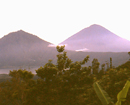
The mountains of Bali are picture postcards | | 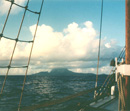
The islands of Asia from the author’s schooner | | 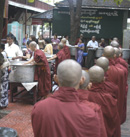
Lunch time for monks | | 
The rivers of Asia are legendary | | 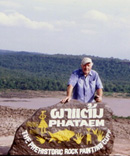
The author at the entrance to famous cave paintings | | 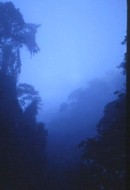
The jungle is all mood ready to be explored | | 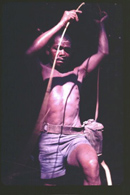
Little is know about the aborigine natives | | 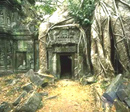
Angkor Wat was re-discovered only 140 years ago | | 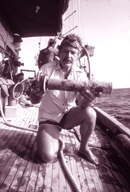
The author with shell casing brought up from HMS Repulse |
|





